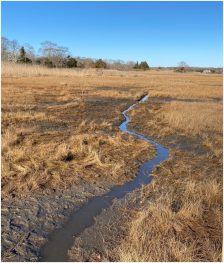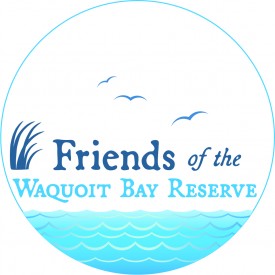Impacts of tidal hydrology on maritime forest and coastal marsh dieback
Project Title: Impacts of tidal hydrology on maritime forest and coastal marsh dieback
Duration: July 2023 – Dec 2023 (continuation of July 2020-present project)
Funding Source(s): NSF, Geological Society of America Student Grant
Principal Investigator: Elizabeth Watson, Stony Brook University (Elizabeth.b.watson@gmail.com )
Onsite Contact: Andrew Payne, Drexel University and the Academy of Natural Sciences (ap3752@drexel.edu)
Project Description: This project will analyze groundwater patterns, salinity, and plant stress using mapping of near-infrared spectral indices, and plant photosynthesis measures to address knowledge gaps in our understanding of the impacts of sea level rise to maritime forests and salt marsh. We are focusing on understanding the proximate causes of marsh forest dieback by building robust and complementary geospatial datasets focusing on key hydrologic factors and plant stress indicators. This project also involves study sites in New Jersey and New York.
Seasonal changes in Salicornia depressa metal accumulation and rhizosphere composition
Seasonal changes in Salicornia depressa metal accumulation and rhizosphere composition
Duration: June 2023—September 2023
Funding Source: Startup grant from the University of Massachusetts Boston to B. Moyers
Principal Investigators, institutional affiliation: Brook Moyers / Alice Palmer
Affiliation: University of Massachusetts Boston, Biology
Email: brook.moyers@umb.edu, alice.palmer001@umb.edu
Project Description: Salicornia species, known in New England as pickleweeds, form mutually beneficial relationships with soil microbes living on the plant’s roots (the rhizosphere), which can help improve plant growth under stressful conditions. They are also capable of accumulating metals from the soil at high concentrations. We are studying how the bacteria present in the Salicornia depressa rhizosphere differ from those in the soil surrounding the plant. We also are interested in how changes in the plants’ biology over the course of the growing season and seasonal changes in salt marsh soil chemistry affect both the rhizosphere’s composition and its ability to accumulate metal from soil. To investigate this, we are collecting samples of S. depressa, its rhizosphere, and the surrounding soil in June, before the plants begin to flower, in August, as they are flowering, and in September, as they begin to senesce. We will sequence bacteria in the rhizosphere and surrounding soil for each timepoint. We will also test the amount of metal in the soil, in S. depressa’s roots, and in S. depressa’s shoots at each timepoint to determine how much metal the plant is accumulating and where it is being stored. These results will help us understand how S. depressa copes with metal stress and its potential in removing metals from polluted marshes.
Restoring hydrology using runnels and salt marsh N biogeochemistry
Project Title: Restoring hydrology using runnels and salt marsh N biogeochemistry
Duration: Aug 2022-Jul 2024
Funding Source(s): Margaret A. Davidson Graduate Fellowship, NOAA
Lead Investigator / onsite-contact: Linda Deegan, Jen Bowen, Meagan Tyrrell
Affiliation: Woodwell Climate Research Center; Northeastern University
Email: hsullivan@woodwellclimate.org
 Project Description: Salt marshes are highly dynamic and variable systems providing many ecosystem services such as shoreline stabilization and nutrient filtration. However, because of their location within the tidal frame and proximity to human activity, they are vulnerable to a combination of anthropogenic and climatic disruptions. The objectives of this project are to understand the effects of altered hydrology via sea-level rise on the vulnerability of salt marsh productivity and N removal, and if restoration can enhance the resiliency to future changes. We will implement a relatively new restoration strategy called runnels, which are shallow channels designed to help drain standing water off the marsh surface and encourage vegetation. This project will examine unintended consequences of such restoration strategies on N cycling.
Project Description: Salt marshes are highly dynamic and variable systems providing many ecosystem services such as shoreline stabilization and nutrient filtration. However, because of their location within the tidal frame and proximity to human activity, they are vulnerable to a combination of anthropogenic and climatic disruptions. The objectives of this project are to understand the effects of altered hydrology via sea-level rise on the vulnerability of salt marsh productivity and N removal, and if restoration can enhance the resiliency to future changes. We will implement a relatively new restoration strategy called runnels, which are shallow channels designed to help drain standing water off the marsh surface and encourage vegetation. This project will examine unintended consequences of such restoration strategies on N cycling.
Impacts of tidal hydrology on maritime forest and coastal marsh dieback
Project Title: Impacts of tidal hydrology on maritime forest and coastal marsh dieback
Duration: July 2022 – Dec 2022 (continuation of July 2020-2021 project)
Funding Source(s): NSF, Geological Society of America Student Grant
Principal Investigator: Elizabeth Watson (Elizabeth.b.watson@gmail.com)
Onsite Contact: Andrew Payne (ap3752@drexel.edu)
Affiliation: Drexel University and the Academy of Natural Sciences
Project Description: This project will analyze groundwater patterns, salinity, and plant stress using mapping of near-infrared spectral indices, and plant photosynthesis measures to address knowledge gaps in our understanding of the impacts of sea level rise to maritime forests and salt marsh. We are focusing on understanding the proximate causes of marsh forest dieback by building robust and complementary geospatial datasets focusing on key hydrologic factors and plant stress indicators. This project also involves study sites in New Jersey and New York.
Pilot Drone Mapping of Marsh Biomass and Species for estimating Vegetation Drag
Title: Pilot Drone Mapping of Marsh Biomass and Species for estimating Vegetation Drag
Lead Investigator / onsite-contact: Heidi Nepf
Affiliation: Civil and Environmental Engineering, Massachusetts Institute of Technology
The flow resistance provided by coastal marshes mitigates flooding by slowing storm surge and damping waves. It also controls the flooding and draining of the marsh platform during the tidal cycle. The flow resistance (drag) provided by a marsh varies with seasonal growth, marsh erosion, and marsh area gained by restoration. It would be useful to have a method that directly measures marsh drag, which would improve the prediction of flooding and inform coastal planning, risk assessment, and restoration design. The Nepf lab has developed models that estimate drag on individual plants as a function of plant shape and rigidity, velocity and flow depth. In this project, we will develop a method to measure the number of plants per bed area and the species using drones to map biomass, plant height, and identifying geometric features. Combining measured plant density (plant per bed area) with predicted drag per plant will yield a measurement of flow resistance per marsh area. MASS DOT will fly the pilot drone mission to measure the spatial distribution of biomass, species, and plant height.
Transfer of a low-cost tidal wetland water level monitoring system: hyperlocal calculations of inundation and tidal datums for understanding change and restoration planning
Title: Transfer of a low-cost tidal wetland water level monitoring system: hyperlocal calculations of inundation and tidal datums for understanding change and restoration planning
Affiliation: Okeanolog/WBNERR
Funding Source: NERRS Science Collaborative Science Transfer gran
Contact/Email: Megan Tyrrell, Research Coordinator, WBNERR (megan.tyrrell@mass.gov)
Abstract: Waquoit Bay Reserve ongoing water level monitoring program focusing on discrete salt marsh microhabitats and employing a simple and inexpensive system of water level monitoring developed by PI Vitalii Sheremet. The ‘Arm-and-Float’ water level instrument uses a HOBO Pendant G accelerometer. These easy to deploy loggers have been used in several types of salt marsh habitats (e.g., pools, creeks and upstream of a tidal restriction) at WBNERR and other NERRs.
The principle of operation is based on converting the raw signal of the arm tilt into the elevation of the float relative to a fixed pivot by multiplication by the arm length. In this way, accuracy of 5-10 mm is achieved, which is adequate for calculating tidal datums for each feature where the logger is deployed. In May 2021, 20 arm-and-float loggers were deployed across Sage Lot Pond for water level monitoring in conjunction with seven other Reserves spanning a range of climactic and tidal regimes which also received arm-and-float loggers as part of the science transfer grant. At the conclusion of this project, locally relevant tidal datums will be calculated, and enhanced understanding of the differences in inundation regime for 20 salt marsh features including creeks, pools, nascent pools, surrounding potential tidal restrictions will be available.
Evaluating the Impact of Hydrologic Alterations on Salt Marsh Sustainability in a Changing Climate
Project Title: Evaluating the Impact of Hydrologic Alterations on Salt Marsh Sustainability in a Changing Climate
Project Partners: Cape Cod Mosquito Control Project, Louisiana State University, National Park Service, United States Fish and Wildlife Service, Rachel Carson National Wildlife Refuge, United States Geologic Survey, Waquoit Bay National Estuarine Research Reserve, Woods Hole Oceanographic Institution
Coastal managers are faced with the challenge of managing marsh hydrology in a way that meets human health needs, optimizes ecosystem services, and supports sustainability. In New England this includes accounting for the effects of ditches that were dug decades ago in 90% of the region’s salt marshes.
Ditches increase marsh drainage and reduce the spatial extent of shallow pools that may represent physical loss of buried soil carbon. However, efficient drainage may reduce the long-term sustainability of marshes by altering below ground biogeochemical and physical processes in a way that results in subsidence and lowered marsh elevation. Managers, restoration practitioners, and scientists at the Waquoit Bay National Estuarine Research Reserve, Woods Hole Oceanographic Institution, U.S. Geological Survey, U.S. Fish and Wildlife Service, National Park Service, and the Cape Cod Mosquito Control Project have expressed a need to understand the tradeoffs of hydrologic management strategies (i.e., ditch remediation, density, maintenance) and identify actions that will achieve user-specified outcomes— such as drainage, maintaining elevation, and carbon burial.
Products:
FACT SHEET: Project Overview
WHOI Website: Marsh Sustainability & Hydrology
Marshes, Mosquitos & Sea Level Rise-Oceanus Magazine Video Link
Marsh Sustainability and Hydrology (MSH) Project Webinar
October 2020
The MSH project is a collaborative research effort involving partners from the University of Georgia, Woods Hole Oceanographic Institution, Louisiana State University, United States Geological Survey, Cape Cod Mosquito Control, US Fish and Wildlife Service, National Park Service and the Waquoit Bay National Estuarine Research Reserve.
Coastal resource managers are tasked with making decisions that simultaneously address the welfare of local communities and the sustainability of salt marshes and the valuable ecosystem services they support. In New England, anthropogenic ditches were dug to reduce shallow ponds on the marsh platform where mosquitos breed, although this may have led to unintended consequences such as lower elevations and increased susceptibility to sea-level rise. In order to evaluate the net impacts of ditching to carbon storage and elevation resilience, we collected cores from the ditched and unditched sections of Great Barnstable Marsh (MA, USA) and measured and compared accretion rates, soil properties, soil organic carbon and ages to determine impact of ditching on marsh sustainability to sea level rise. A geomorphic model calibrated with field data was used to develop a decision support tool to help managers assess impact of different management strategies on salt marsh sustainability and ecosystem service delivery.
To view the workshop presentations please go to: Marsh Sustainability and Hydrology Project Webinar Presentation Videos
MSH Team Members:
Amanda Spivak, Principal Investigator, University of Georgia
Sheron Luk, PhD Student, Woods Hole Oceanographic Institution
Meagan Eagle, United States Geological Survey
Gabrielle Sakolsky, Director, Cape Cod Mosquito Control
Susan Adamovich, US Fish and Wildlife Service
Giulio Mariotti, Louisiana State University
Megan Tyrrell, Research Coordinator, Waquoit Bay National Estuarine Research Reserve
Tonna-Marie Surgeon Rogers, Director, Waquoit Bay National Estuarine Research Reserve
Sediment dynamics and hydrographic conditions during storm passage, Waquoit Bay, Massachusetts
Project Title: Sediment dynamics and hydrographic conditions during storm passage, Waquoit Bay, Massachusetts
Date: 2016
Principal Investigator(s): Maio, C.V., Donnelly, J.P., Sullivan, R., Madsen, S.M., Weidman, C.R., Gontz, A.M., & Sheremet, V.A.
Affiliations:
Summary: Marine Geology, 381, 67-86. http://www.sciencedirect.com/science/article/pii/S0025322716301438
Monitoring wind waves in Nantucket Sound off South Cape Beach
Project Title: Monitoring wind waves in Nantucket Sound off South Cape Beach
Date: 2016
Principals: Maxim Sheremet (Sturgis Charter Public School), Chris Weidman (retired, WBNERR)
Presentation/Poster: Natural History Conference 2016 South Cape Beach Wave Exp_Poster_NaturalHistoryConference_2016
Remotely Determining Tidal Currents and Volumetric Discharge
Erika D. Johnson
Woods Hole Oceanographic Institution
Funding Source(s): Woods Hole Oceanographic Institution
Land–sea coupling and global-driven forcing: following some of Scott Nixon’s challenges
Project Title: Land–sea coupling and global-driven forcing: following some of Scott Nixon’s challenges
Date: 2015
Principal Investigator(s): Valiela, I. & Bartholomew, M.
Summary: Adjoined watershed–estuary–coastal ecosystems are coupled by biogeochemical and hydrodynamic processes, as Scott Nixon repeatedly argued in his many contributions. Case histories from Waquoit Bay and the Pacific Coast of Panama, supplemented by information from other sites, make evident that the couplings that enable connectivity among spatially separate landscape units, while highly subject to detailed local contingencies, take place in every coastal zone, can be powerfully affected by human activities on land, and by global-scale forcings, as Scott Nixon often reminded us. Read full text…Estuaries and Coasts 38: 1189. doi:10.1007/s12237-01498083. https://link.springer.com/article/10.1007/s12237-014-9808-3
In-situ ecosystem metabolism measured by eddy correlation
PI: Matthew Long, WHOI
Funding: WHOI
Estuarine Hydrodynamics – the velocity field, tides, seiching, and storm-generated currents
Project Title: Estuarine Hydrodynamics – the velocity field, tides, seiching, and storm-generated currents
Date: 2013
Principal Investigators: Vitalii Sheremet, University of RI, NOAA NMFS Research Fellow, Chris Weidman, WBNERR
Funding: NOAA NMFS Research Fellowship, WBNERR collaborative in-kind
Development of Low-cost, In-situ, Precision Hydrodynamic Instrumentation for Measurement of Tides, Currents and Waves
Project Title: Development of Low-cost, In-situ, Precision Hydrodynamic Instrumentation for Measurement of Tides, Currents and Waves
PI: Vitalii Sheremet, University of RI, NOAA NMFS Research Fellow
Funding: NOAA NMFS Research Fellowship, WBNERR collaborative in-kind
Summary: An inexpensive current meter based on the drag principle is being designed and developed. It provides a simple, elegant, robust, and low-cost solution for measuring currents at the ocean bottom or from any fixed platform. Its operation is based on the drag law of a buoyant tethered cylinder in flowing water. Three-axis accelerometers measure tilts which are converted to a horizontal velocity vector. Special tethered attachment enables estimation of not only the magnitude but also horizontal direction of the current. The same accelerometers are also used to construct a simple stick-and-float tide gauge.
The performance of the instruments is being evaluated in field tests in Waquoit Bay and Nantucket Sound. Arrays of the instruments deployed for periods from days to months are used to record tidal and higher frequency oscillations in the Waquoit Bay. A dramatic double peaked flood (double height) tide arising from nonlinear interaction with bathymetry is studied. Strong seiches with periods of about 15-30 minutes are also recorded in some parts of the Waquoit Bay system.
Collaborative Research


